Explore the
BigCommerce platform
Get a demo of our platform to see if we’re the right fit for your business.
Not ready for a demo? Start a free trial
Facebook Remarketing: Using Targeted Advertising Campaigns To Increase Sales
Johnathan Dane
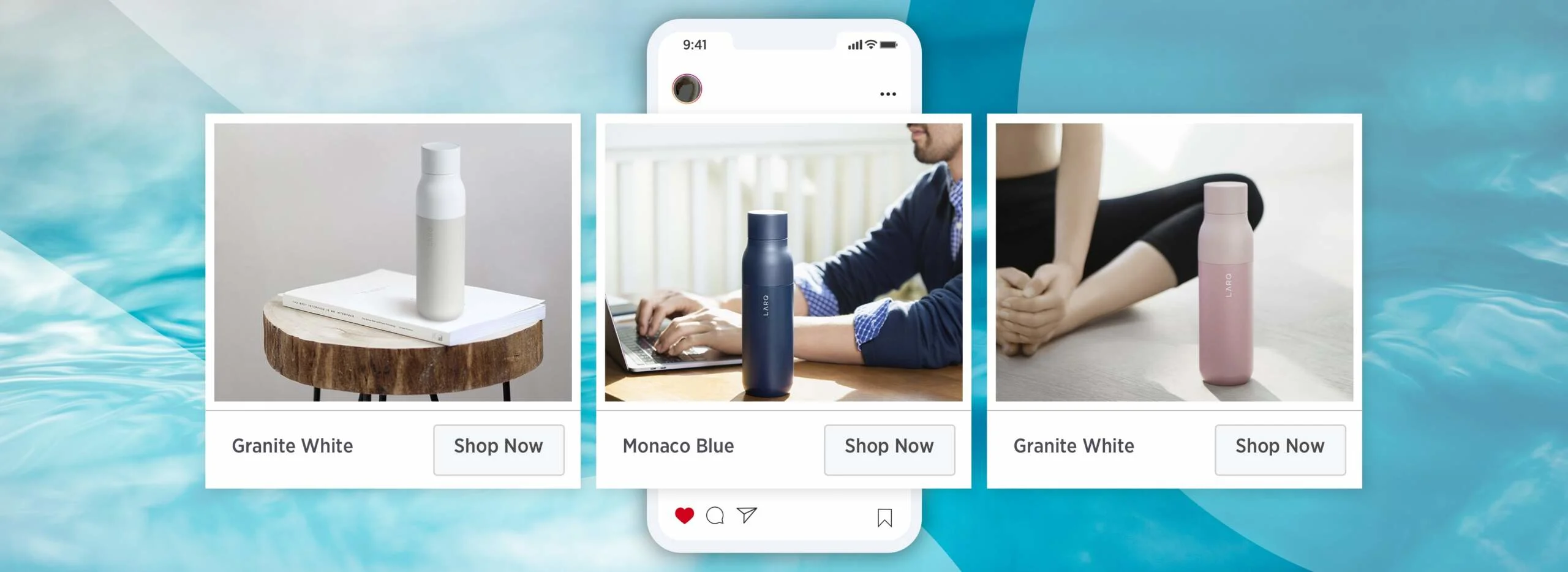

Facebook Remarketing: Using Targeted Advertising Campaigns To Increase Sales
Get The Print Version
Tired of scrolling? Download a PDF version for easier offline reading and sharing with coworkers.
A link to download the PDF will arrive in your inbox shortly.
Digital cart abandonment is at an all-time high.
Recent studies show that the average abandonment is above 75 percent – and rising.
In other words, three out of every four shoppers on your website that actually go through the trouble of putting items in their cart just disappear.
Just imagine how much money you’re leaving on the table with these missed conversions.
Today, advertisers need to be more clever than ever to reel in these potential customers/leads.
Fortunately, remarketing allows you to keep your brand fresh in potential customers’ minds by following them around the web with targeted messages.
While the task might sound daunting, platforms that depend on advertisements like Google and Facebook make it surprisingly easy.
And social remarketing platforms are especially effective at generating a high ROAS, if you know how to set them up properly.
Let’s take a look at Facebook remarketing to get a better idea of how it can help improve your social campaigns and close more of those nearly-converting cart abandoners.
What Is Facebook Remarketing?
Before we dive in, let’s clarify what remarketing is and why it’s important.
Remarketing (or “retargeting,” depending on who you ask) shows your custom ads to users who have already engaged with your brand online.
When users visit your website, landing page, or social media page, a cookie or pixel is added to their browser and lets your ads “follow” them to other digital spaces with content based on the info in your cookie.

Wherever your users roam, their cookies will follow. – image source
Remarketing is a proven tactic for enticing customers who escaped your sales funnel to come back and convert.
For example:
Visitors who see remarketing ads are 70% more likely to convert on a website compared to those who don’t.
In a joint study, comScore and ValueClick Media found that remarketing lifted trademark scores by 1,046%, the highest performance out of six targeting strategies tested.
Only 11% of consumers had a negative reaction to remarketing ads in an eMarketer study, while 30% of buyers who noticed responded positively.
Facebook remarketing is especially potent because of how specific the available targeting and tracking data is.
By zeroing in on specific users who took specific actions, you can use Meta Pixel to:
Reinforce your message to users who viewed specific pages.
Show targeted ads to visitors who bounced.
Upsell and cross-sell new items to past purchasers.
Encourage visitors to learn more or complete a purchase.
and lots more.
Finally, despite the recent growth of other social networks, Facebook is still the standard for digital marketing success.
In a (different) eMarketer survey, more than 95% of social media marketers named Facebook as the best social network for producing ROI for their clients.
These results placed Facebook well ahead of Twitter (63.5%), Instagram (40.1%) and Snapchat (2.1%).
So in a nutshell, if you’re planning to use targeted advertising to increase sales, Facebook is probably the best place to start.
But that’s enough about how valuable Facebook is as a remarketing asset — let’s move on from the “why” and get into the “how” already.

Let’s not spend any longer in this nutshell than we have to. – image source
Maximize Your Paid Advertising
If you’re going to target specific Facebook users, it’s important to know what specific goals and actions you’re trying to initiate with your ads, especially since you’re using real budget dollars to reach them.
Remarketing is a great way to both fill-up and plug holes in your sales funnel — starting with one key leak near the bottom.
1. Reduce Cart Abandonment.
Did you know that if abandoned digital shopping carts were real shopping carts and you stacked them all up, they would reach the moon?
OK, that might not technically be true.
But abandoned digital carts are a real problem, and they aren’t going away.
In fact, the Baymard Institute’s collection of abandonment rate statistics shows the number of ditched carts going up, from around 60% in the late 2000s to higher than 80% in some cases today.
Remarketing on Facebook makes it possible for you to reach these “ghosts” and remind them that they probably still want that thing they were about to buy and that it’s not too late.
Facebook even offers specific “event codes” for granular on-site actions, so you can craft specific ads to reach users who added an item to a shopping cart or a wishlist.
2. Keep Your Product Fresh.
In addition to reaching cart abandoners, Facebook’s remarketing system lets you target users who visited specific product pages but didn’t put items in a cart.
These users are good targets for remarketing because visiting product pages typically indicates both interest and purchase intent.
They might even be looking at different versions of the same product on different sites before committing to a purchase.
Dynamic Facebook ads keep your products and your brand fresh in this audience’s mind.
By targeting users who clicked into specific products and excluding those who reached the “Order Complete” page, you can reconnect with visitors who weren’t ready to convert then but might be ready now.
And as a bonus, you’ve taken a sale away from the competition!
Another great strategy to use is link retargeting. It allows you to retarget ads to people who have already interacted with a link in your social media post. This adds potential customers to your retargeting funnel even when they haven’t visited your website yet.
3. Offer Special Incentives To Motivate Customers To Buy.
Customers who engage with your branded content but don’t convert are also ripe for remarketing on Facebook.
These visitors have already shared their personal information for access to gated content like a webinar or an ebook.
Basically, they climbed into your marketing funnel voluntarily, which makes them more likely to respond when you offer an incentive.

“No one told me the funnel was this small when I climbed in.” – image source
Special incentives for an audience that has shared their contact information can include sales-based ads targeting first-time purchasers or limited-time discounts for popular products.
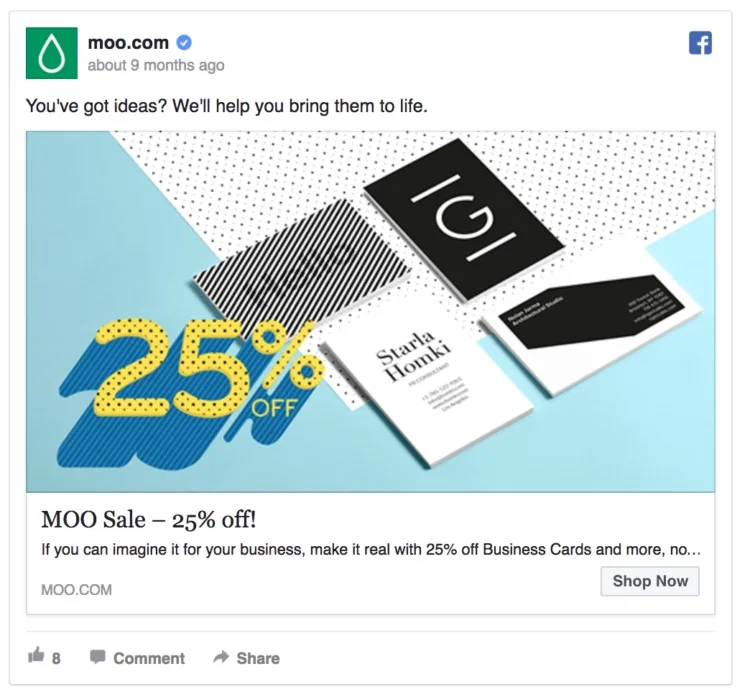
In this example, MOO offers a small discount on their entire product line for select leads. – image source
Sometimes an audience still needs nurturing at this stage. If that’s the case, you can create ads that offer a free trial to keep leads engaged and moving through your marketing funnel.
4. Target Based Off Specific Behavior.
If you really want to lure your cart abandoners back, Facebook’s tracking pixel makes it possible to run targeted ads based on the behavior of visitors who bounced.
For example, you can use Facebook remarketing to reach users based on the device they used, activities they completed, and more.
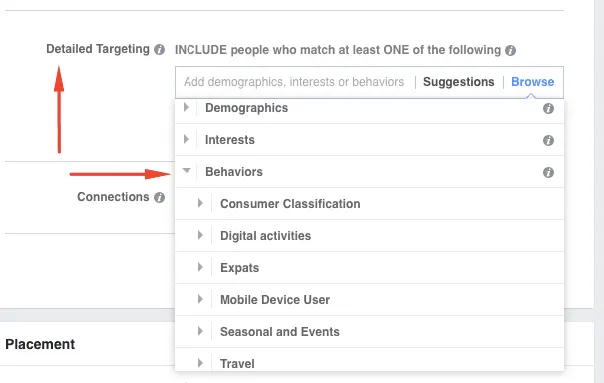
Just a sample of the options available in the Behaviors menu. – image source
Other user behaviors can demonstrate greater interest, like the amount of pages they visit, whether or not they scroll all the way to the end of an offer page, and other criteria.
Creating a Facebook remarketing campaign makes it easier to analyze this information and use it to improve your advertising efforts.
The next step is setting up Custom Audiences to further segment and personalize your message for your prospects.
Targeting A Custom Audience
Facebook’s Custom Audience tool is designed to put your remarketing ads in front of people who are already interested in your product or brand.
You (or your marketing team) can create Custom Audiences based on data that includes:
Your existing customers and sales prospects.
Website traffic (all users or specific page visitors).
Actions in mobile apps.
Each of these targets presents its own opportunities — and requires its own strategy.
1. Current Customers
When you’re setting up your Facebook remarketing campaign, customers who have already purchased from you are an ideal place to start.
In terms of low-hanging fruit, it doesn’t get much riper than this.
After all, a study by Adobe found repeat customers are responsible for 41% of eCommerce revenue in the U.S., even though only 8% typically return for more business.
Repeat purchasers also spend almost five times as much per visit compared to regular shoppers.
You can recapture some of these customers with targeted Facebook ads.
Your remarketing campaign can announce new versions of your customers’ past purchases, or offer discounts and cross-promotions for related products.
In the example below, Airbnb’s Facebook audience can ‘Book Now,’ which implies comfort and experience with their brand:
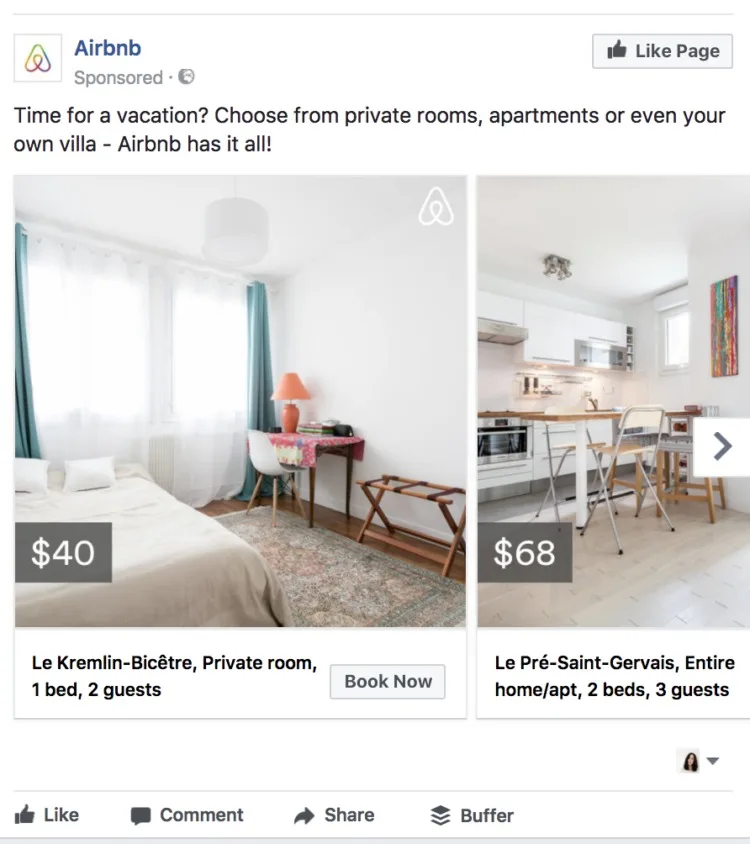
Hopefully this audience is also comfortable with modular Swedish architecture. – image source
If you plan to target your existing customers, it’s best not to hit them with a hard sell.
You can build on their existing relationship with your brand by offering quantity-based discounts or holiday sales, so they can share their love of your stuff with others.
Also, remarketing doesn’t have to be isolated to upsells and cart abandonments.
You can also leverage these remarketing campaigns to turn existing customers into brand advocates.
2. Website Traffic And Behavior
If you’re adding Facebook remarketing to your digital advertising toolkit, you probably have an established online presence already.
This means that your website is getting at least some regular traffic that doesn’t convert.
Even though these leads won’t be as likely to convert as your past customers, remarketing to this audience can still help reduce your ad spend significantly.
They’ve already shown interest, which makes them a higher-value target than someone unfamiliar with your brand.
To reach these users, select ‘Website Traffic’ in your Custom Audience builder and enter the URL of the page you want to base your remarketing on.
The Facebook pixel notes when a user visits your chosen site and, if possible, connects that user to a Facebook profile that will see your remarketing ads.

Note: the “People visiting specific web pages but not others” option is helpful for excluding traffic that converted already. – image source
Remember, these aren’t existing customers you’re trying to bring back into the fold — they’re casual browsers who might be enticed into the next step in your marketing funnel.
Use general ads that focus on new products, benefits, and discount codes to catch their attention.
While it might seem like this strategy isn’t much better than a shot in the dark, the average click-through rate (CTR) for remarketing ads is still ten times higher than standard display ads.
3. App Activity
If you have a custom iOS or Android app that customers are using, you can remarket to them on Facebook based on specific in-app activity.
And with social media growing more prevalent every day, ignoring this potential audience is a mistake you can’t afford to make.
To set this up, you’ll need to register your app with Facebook and choose actions or events that will trigger your ads.
These can be predefined or custom events ranging from opening the app for the first time to adding payment info and making purchases.
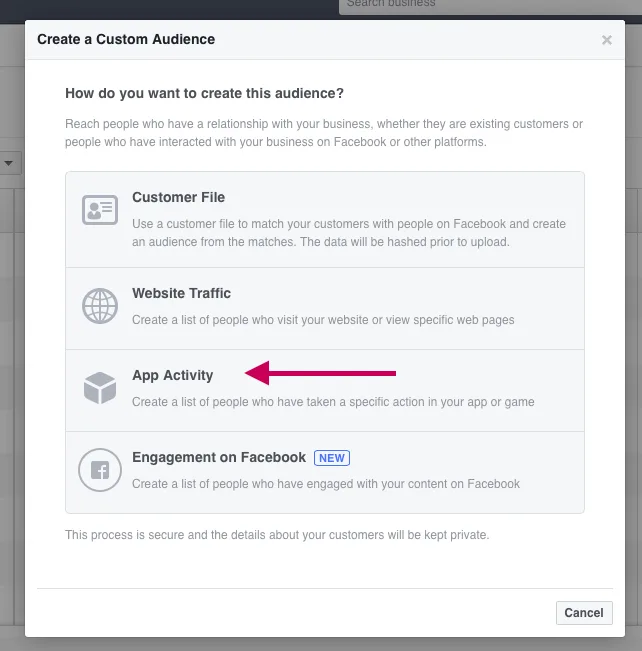
Choose “App Activity” in the “Create a Custom Audience” menu to get started. – image source
Custom audiences also allow you to choose the timeframe you want to use for your campaign.
For example, you can reach users who’ve made in-app purchases by specifying “In The Last 30 days” to reach people who have completed a defined “purchase event” in the past month. (Unless it’s February.)
Note: For more, check out Facebook’s guide to creating Custom Audiences for your app ads.
4 Tips To Get The Most Out Of Your Facebook Remarketing Campaigns
A recent survey shared by Small Business Trends said that more than 60 percent of business owners think their Facebook ads aren’t reaching their ideal audience.
While some of these results may be related to a lack of understanding of the platform, there are real steps that businesses and agencies can take to reach the right users and improve conversion rates.
1. Make Sure Your Ads Are Relevant To The Audience
The most effective way to reach your ideal audience is to ruthlessly refine your targeting.
The user interface in Facebook’s remarketing system tends to emphasize demographic data, which is both the most reliable and most broad information available.
But demographic data alone won’t put you in front of your target audience.
Tools like interests and exclusions can make your targeting hyper-specific and reduce wasted budget on irrelevant impressions.

Interests and exclusions can be customized in “either/or/and” combinations to refine or expand your targeting. – image source
You can also make sure your ads are relevant by creating a separate advertising campaign for every stage of your Facebook marketing funnel.
After all, your Facebook audience has varying interests and expectations just like any other.
You’ll need a strategy that addresses these various goals and provides solutions.
With the right adjustments, your Facebook remarketing campaign can show leads the exact right ads based on their position in your marketing funnel.
2. Target Those Who Are Most Likely To Buy
Like the tip above, this might seem fairly obvious based on what you’ve learned already.
But Facebook’s Custom Audience settings let you drill down into even more detail to reach users who have demonstrated a more intense interest in your brand.
For example, you can create a remarketing campaign to target blog readers using the ‘website traffic’ parameters outlined above.
But you can single out your high-ROI blog audience with specific adjustments like:
Targeting visitors who viewed more than one blog post.
Targeting visitors who viewed a blog post and a landing page.
Targeting visitors who viewed a post and your Pricing page (indicating interest in your product).

Moving targets are always the hardest to hit. – image source
Similar updates can be made for other visitors who have engaged with your content on a more intense level.
While we can’t recommend excluding your haystack to chase needles, Facebook remarketing makes it possible to reach those high-value targets through levels of segmentation, and failing to do so could be a missed opportunity for your campaign.
3. Use Facebook’s Lookalike Audiences
You’ve learned how to create a Custom Audience based on your existing information, or tracking data from your website or mobile app.
When you want to reach beyond these limits, you can create a lookalike audience.
Facebook creates lookalike audiences by finding users with attributes that align with your base audience.
These filters can be “layered” onto your Custom Audience settings to find leads that might fit your profile.
For example, let’s say you import a list of users who have downloaded your ebook to create your Custom Audience.
Facebook can generate a lookalike audience of similar users who share characteristics and interests with your existing prospect data.

Sometimes the lookalikes can be a little too close for comfort. – image source
While these prospects might not be familiar with your brand or products, the targeting information that brings them into your advertising sphere means that these leads are still more likely to convert than someone with no interest in your business or industry at all.
Lookalike audiences are a great way to expand your highly refined remarketing audiences so you can reach a broader pool of qualified potential customers/leads.
4. Timing Is Everything
We mentioned above that one of the benefits of Facebook remarketing is keeping your product and brand fresh in a potential lead’s mind.
For your campaign to be effective, it’s important to hit that sweet spot between “too soon” and “what is this again?”
The timing of your campaign is customizable and should be based on your customers.
If your sales cycle is short, Facebook suggests remarketing to website visitors from the past 15 to 30 days.
For transactions that require more touch points, you can elongate your recency window to keep users moving through your funnel.
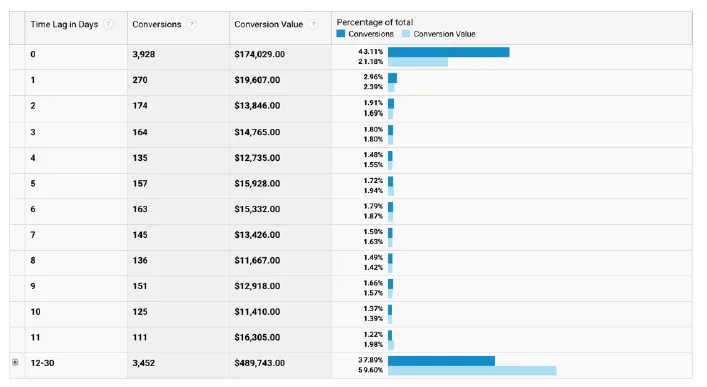
More than half of the conversion value happened in the “12-30 days” segment of this campaign, making it a good candidate for extending the recency window. – image source
And speaking of exclusion, we’ve all seen remarketing campaigns that try to sell us products we’ve already purchased, right?
These redundancies are important to avoid — they waste your ad spend and don’t give your customer a good reason to come back for more.
To that end, you can set up your Facebook campaign to leave out users who recently converted for a defined period.
Most B2C remarketing campaigns exclude recent purchasers for about one to two weeks, unless you have specific cross-selling opportunities to promote.
Executive Summary
Facebook is one of the most reliable performers for social media marketing, and just about any company investing in online ad spend can capitalize on the opportunities this tactic provides.
These remarketing campaigns can maximize your paid advertising by keeping your brand fresh in leads’ minds, offering incentives to convert, and reducing cart abandonment.
To get the most out of your campaign, refine your targeting to ensure only relevant users are seeing your ads, engage high-value and lookalike audiences, and time your campaigns to maximize customer interest and avoid redundancies.
Have you used Facebook remarketing to target your audience? Tell us about it in the comments below!



